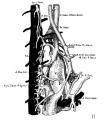Talk:Paper - The development of the vena cava inferior in man: Difference between revisions
(Created page with " {{Ref-McClure1925}} Numerous embryos have been examined, and those at important and critical stages were reconstructed in wax after the method of Born. The following is th...") |
mNo edit summary |
||
| Line 34: | Line 34: | ||
<gallery> | <gallery> | ||
File:McClure1925 fig01.jpg|Fig. 1 4 mm | File:McClure1925 fig01.jpg|Fig. 1 human embryo 4 mm [[:Category:Carnegie Embryo 588|no. 588]] | ||
File:McClure1925 fig02.jpg|Fig. 2 | File:McClure1925 fig02.jpg|Fig. 2 mm human embryo 4 mm [[:Category:Carnegie Embryo 588|no. 588]] | ||
File:McClure1925 fig03.jpg|Fig. 3 11 mm | File:McClure1925 fig03.jpg|Fig. 3 human embryo 11 mm Columbia University Collection, no. 1095 | ||
File:McClure1925 fig04.jpg|Fig. 4 11 mm | File:McClure1925 fig04.jpg|Fig. 4 human embryo 11 mm Columbia University Collection, no. 1095 | ||
File:McClure1925 fig05.jpg|Fig. 5 10.1 mm | File:McClure1925 fig05.jpg|Fig. 5 human embryo 10.1 mm [[:Category:Carnegie Embryo 623|no. 588]] ([[Carnegie stage 17]]) | ||
File:McClure1925 fig06.jpg|Fig. 6 10.1 mm | File:McClure1925 fig06.jpg|Fig. 6 human embryo 10.1 mm [[:Category:Carnegie Embryo 623|no. 588]] ([[Carnegie stage 17]]) | ||
File:McClure1925 fig07.jpg|Fig. 7 15 mm | File:McClure1925 fig07.jpg|Fig. 7 human embryo 15 mm [[:Category:Carnegie Embryo 841|no. 841]] ([[Carnegie stage 18]]) | ||
File:McClure1925 fig08.jpg|Fig. 8 15 mm | File:McClure1925 fig08.jpg|Fig. 8 human embryo 15 mm [[:Category:Carnegie Embryo 841|no. 841]] ([[Carnegie stage 18]]) | ||
File:McClure1925 fig09.jpg|Fig. 9 15 mm | File:McClure1925 fig09.jpg|Fig. 9 human embryo 15 mm Harvard Collection, no. 2051 | ||
File:McClure1925 fig10.jpg|Fig. 10 15 mm | File:McClure1925 fig10.jpg|Fig. 10 human embryo 15 mm Harvard Collection, no. 2051 Ventrolateral aspect. | ||
File:McClure1925 fig11.jpg|Fig. 11 15 mm | File:McClure1925 fig11.jpg|Fig. 11 human embryo 15 mm Harvard Collection, no. 2051 venous ring of right side | ||
File:McClure1925 fig12.jpg|Fig. 12 16 mm | File:McClure1925 fig12.jpg|Fig. 12 human embryo 16 mm Columbia University Collection, no. 1024 | ||
File:McClure1925 fig13.jpg|Fig. 13 16 mm | File:McClure1925 fig13.jpg|Fig. 13 human embryo 16 mm Columbia University Collection, no. 1024 | ||
File:McClure1925 fig14.jpg|Fig. 14 22 mm | File:McClure1925 fig14.jpg|Fig. 14 human embryo 22 mm Columbia University Collection, no. 1090 | ||
File:McClure1925 fig15.jpg|Fig. 15 22 mm | File:McClure1925 fig15.jpg|Fig. 15 human embryo 22 mm Columbia University Collection, no. 1090 | ||
File:McClure1925 fig16.jpg|Fig. 16 45 mm | File:McClure1925 fig16.jpg|Fig. 16 human embryo 45 mm Harvard Collection, no. 2128 | ||
File:McClure1925 fig17.jpg|Fig. 17 venous system of adult man | File:McClure1925 fig17.jpg|Fig. 17 venous system of adult man | ||
File:McClure1925 fig18.jpg|Fig. 18 embryonic veins of the domestic cat | File:McClure1925 fig18.jpg|Fig. 18 embryonic veins of the domestic cat | ||
</gallery> | </gallery> | ||
Latest revision as of 10:51, 19 January 2017
McClure CFW. and Butler EG. The development of the vena cava inferior in man. (1925) Amer. J Anat. 35(3): 331-383.
Numerous embryos have been examined, and those at important and critical stages were reconstructed in wax after the method of Born.
The following is the series of human embryos actually made use of in this investigation:
Carnegie Embryological Collection (Baltimore)
- No. 588, 4 mm embryo (reconstructed x 150)
- No. 800, 6.5 mm embryo
- No. 623, 10.1 mm embryo (reconstructed x 100)
- No. 841, 15 mm embryo (reconstructed x 100)
Embryological Collection of the College of Physicians and Surgeons (P And S) of Columbia University (New York)
- No. 1095, 11 mm embryo (reconstructed x 100)
- No. 1024, 16 mm embryo (reconstructed x 100)
- No. 1090, 22 mm embryo (reconstructed x 100)
Embryological Collection Of Cornell University Medical College (New York)
- 10.2 mm embryo
- 14 mm embryo
- 15 mm embryo
- 19 mm embryo
Harvard Embryological Collection (Boston)
- No. 2051, 15 mm embryo (reconstructed x 100).
- No. 1913, 18 mm embryo (reconstructed by Huntington and McClure in 1915).
- No. 2924, 25 mm embryo
- No. 2128, 45 mm embryo (reconstructed x 50).
Owing largely to the circumstance of our obtaining material from these several collections, we found that the recorded length of the various embryos cannot always be taken as indicating exactly their relative ages. Our studies have shown that the embryos examined by us can be arranged, at least so far as the development of the venous system is concerned, in the following series according to age: 4 mm (Carnegie, no. 588); 6.5 mm (Carnegie, no. 800); 10.2 mm (Cornell); 11 mm (P and S, no. 1095); 10.1 mm (Carnegie, no. 623); 15 mm (Cornell); 15 mm (Carnegie, no. 841); 15 mm (Harvard, no. 2051); 14 mm (Cornell); 16 mm (P and S, no. 1024) ; 18 mm (Harvard, no. 1913) ; 19 mm (Cornell) ; 22 mm (P and S, no. 1090) ; 25 mm (Harvard, no. 2924) and 45 mm (Harvard, no. 2128). We have also observed that all of the really significant transformations of the embryonic veins, leading up to the establishment of the inferior vena cava, take place largely in embryos measuring approximately between 10 and 18 mm in length.
Fig. 1 human embryo 4 mm no. 588
Fig. 2 mm human embryo 4 mm no. 588
Fig. 5 human embryo 10.1 mm no. 588 (Carnegie stage 17)
Fig. 6 human embryo 10.1 mm no. 588 (Carnegie stage 17)
Fig. 7 human embryo 15 mm no. 841 (Carnegie stage 18)
Fig. 8 human embryo 15 mm no. 841 (Carnegie stage 18)

















